Equity and health in housing coverage: A preliminary news analysis from Northern California
Wednesday, May 29, 2019Housing impacts health in widespread, well-documented ways that affect both quality and length of life.1 As a key determinant of health, housing instability stands to widen already stark racial and health inequities. As such, a growing number of public health organizations and practitioners are seeking ways to ensure all residents have access to safe, affordable homes.
While the connection between housing and health is clear, there is less research and even fewer recommendations on how public health practitioners can engage in addressing this challenging issue. This is especially true when it comes to communication, leaving public health practitioners with little guidance on how they can talk about housing strategically to support policy and systems changes that decrease racial and health inequities.
Understanding how the news media frame housing policy — and whether a health frame is included — can help address this research gap and support practitioners in more effectively strengthening housing policy. That’s because news coverage provides a window into the public discourse around any issue and sets the agenda for what issues the public and policymakers think about — and how they think about them.2,3,4,5,6 News coverage also influences what solutions people support.
To better understand how the housing crisis is portrayed in the news, Berkeley Media Studies Group analyzed coverage from the San Francisco Bay Area — the epicenter of the crisis — and paid special attention to how equity and health appear in the news, providing insights for housing advocates working across the country.7
Background
Complex policy decisions at the local, state, and federal levels contribute to increasing housing costs, housing instability, and poor health outcomes. In response to the San Francisco Bay Area’s housing crisis, a diverse, multisector set of partners called The Committee to House the Bay Area, or CASA, created a set of local, regional, and state policy and funding recommendations, called the CASA Compact. To push CASA to emphasize equity and health, the Bay Area Regional Health Inequities Initiative (BARHII), a coalition of 11 Bay Area local health departments, facilitated an equity cabinet of public health and tenants’ rights organizations. The cabinet was funded by the San Francisco Foundation and worked to ensure equity and health appeared in both the CASA recommendations and news coverage. This group inserted equity and health into the public conversation about CASA and successfully influenced the CASA process to ensure that it included some of the priorities of renters, communities of color, and others most affected by the health consequences of the Bay Area’s housing instability.
One of the equity cabinet’s key policy and communication strategies has been focusing on what BARHII, and now CASA, refers to as the 3Ps: protecting people from displacement, preserving existing affordable housing, and producing new affordable housing. This focus on setting and meeting concrete goals for the 3Ps kept the conversation solutions-focused and maintained many of the protection and preservation strategies championed by tenants, despite strong political pressure to weaken or remove them.
Like many health equity issues, the causes and solutions to the housing crisis in the Bay Area are complicated. Even with the equity cabinet working to keep equity and health at the forefront, cabinet members and other groups have been concerned that the recommendations do not go far enough to advance equitable solutions for the communities hardest hit by the housing crisis and could lead to further displacement of communities of color from urban areas. Additionally, some smaller jurisdictions with wealthier populations have voiced concerns that the CASA Compact’s regionally focused recommendations infringe on local control and will diminish the “small-town” atmosphere by increasing density and affordable housing; this will make keeping policy and communication focused on health equity an ongoing challenge.
What we did
The complex CASA process makes it a unique window through which to evaluate news about housing. In BMSG’s news analysis, we wanted to know:
- When the CASA Compact appeared in Bay Area news coverage, how did it compare with coverage of the housing crisis more broadly?
- How did the 3Ps (preservation, protection, and production) appear in news coverage about CASA and about the wider housing crisis?
- Were equity and health part of the news conversation about CASA?
- What can we learn from this analysis that helps others working at the intersection of housing and health and points to future research questions?
In this news analysis, we collected articles that mentioned CASA or the CASA Compact, using the Nexis database. The first article we identified was published in May 2017, and we gathered all coverage through February 15, 2019. Trained coders analyzed the articles to assess how CASA was framed in the news, who was quoted, and how issues of equity or health appeared in connection to housing.
We also used MediaCloud to identify news coverage of the Bay Area housing crisis in general during the same time period and to see how, if at all, it differed from coverage that discussed the CASA Compact.
What we found
We found 118 articles published in San Francisco Bay Area news outlets (ranging from major newspapers to smaller online outlets) that substantively discussed CASA. During the same time period, we found 22,809 articles about the general Bay Area housing crisis.
Figure 1: Articles that reference CASA over time (n=118)
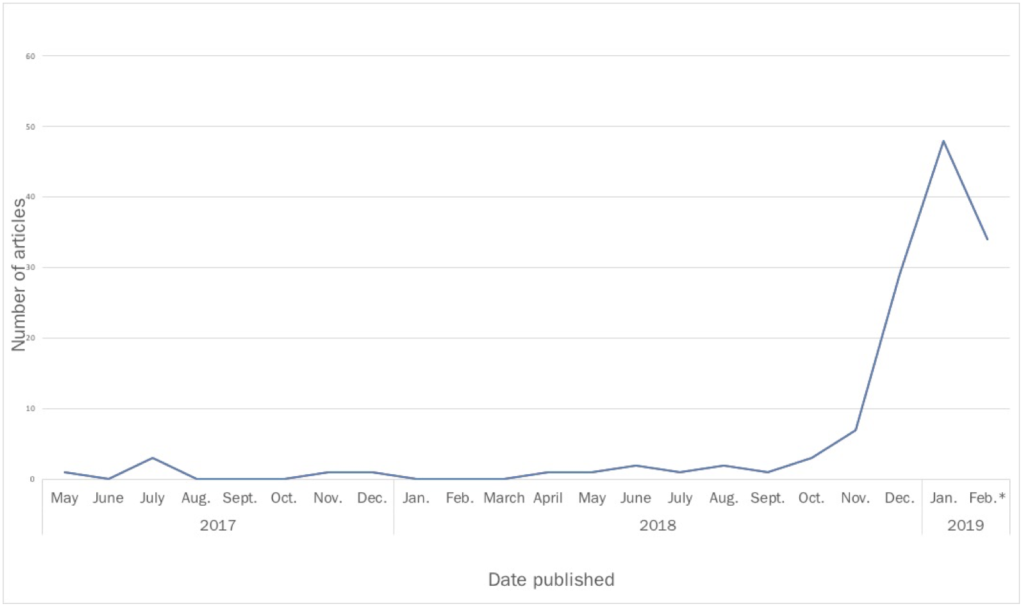
Fewer than 10 articles a month mentioned CASA until the end of 2018 when the release of the Compact garnered significant coverage in local news outlets. Just over half (51%) of articles about CASA were news stories, while 49% were opinion pieces, such as op-eds, letters to the editor, or unsigned editorials.
How are solutions to the housing crisis framed?
Research shows that both advocacy messages and news coverage often focus on the problem rather than the solution, which can make complex problems seem intractable and can slow the momentum for solutions that lead to equity and health.8
Our analysis found that news coverage of CASA contained a strong emphasis on solutions. Compared to stories about the broader housing crisis, stories about CASA were more likely to discuss one or more of the 3Ps as a solution (see Table 1). Across both types of coverage, housing production was the most covered solution (60% in general housing news versus 78% in news about CASA).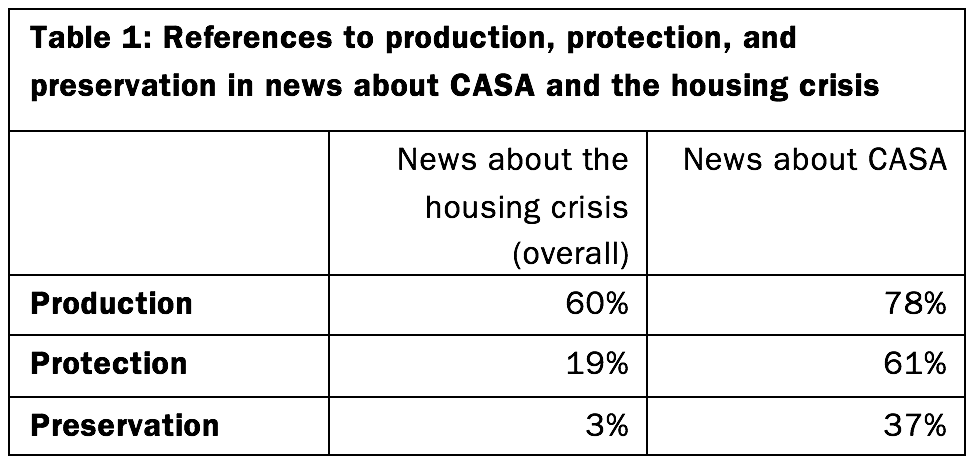
Significantly, we also found that the more controversial protection and preservation strategies, which centered equity and were championed by tenants’ rights organizations, appeared far more often in CASA coverage than in general stories about the housing crisis. Protection appeared in only 19% of stories about the housing crisis versus 61% of the stories about CASA, while preservation appeared in only 3% of the stories about the housing crisis versus 37% of stories about CASA.
Even in the CASA coverage, however, we found that preservation strategies were only discussed in about one-third of articles, and they were often mentioned only in passing. In addition, the connections among the 3Ps of housing, including key equity connections, such as the need for applying protection strategies before production incentives are introduced, were discussed in only a handful of articles.
How do equity and health issues appear in the news about CASA?
Public health organizations and tenants’ rights groups were pushing for both the CASA recommendations and the news coverage to frame housing as a health issue and focus on equity-based solutions. Therefore, we were interested in learning how equity and health appeared in the news and how these issues intersected.
Figure 2: References to equity and health in news about CASA (n-118)
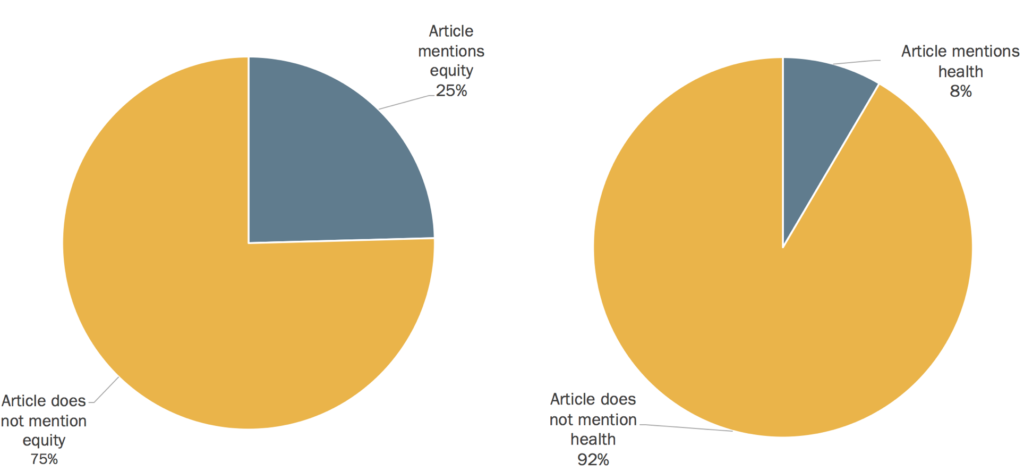
About a quarter of articles (25%) discussed equity in connection to housing, such as the displacement of communities of color and low-income families (see Figure 2). These were most often discussions of income inequality; explicit references to racial inequity were relatively rare. References to equity appeared in both news stories and opinion pieces. In one news article, for example, a representative of a community organization noted, “Prioritizing those hardest-hit by the housing affordability crisis is paramount.”9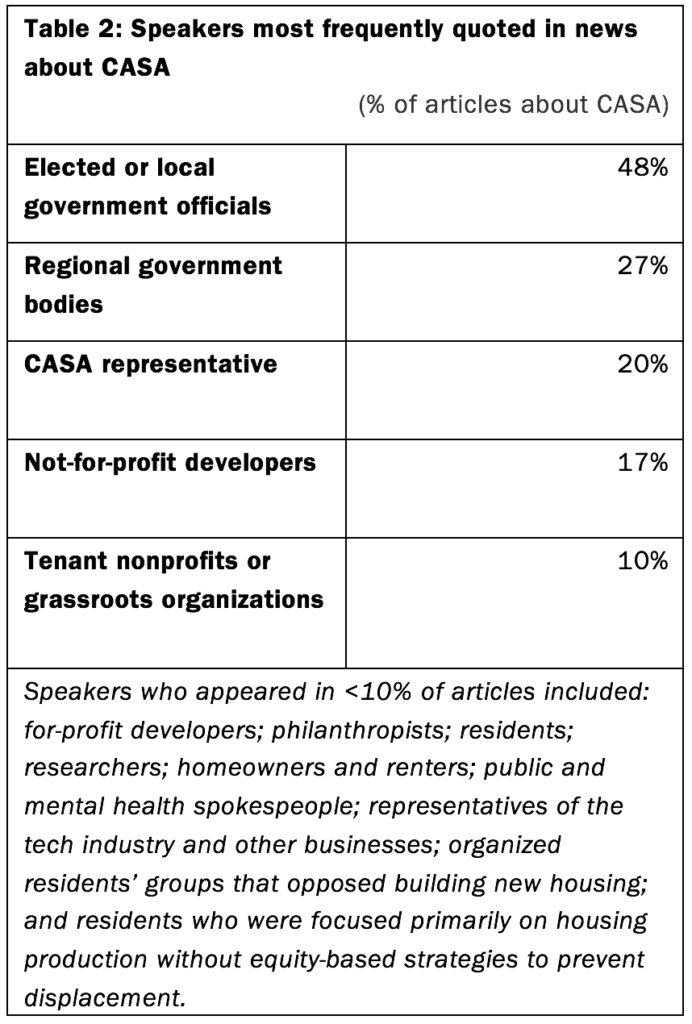
Very few articles about CASA (8%) discussed health in relation to housing. When the connection between housing and health appeared, it was often in opinion pieces or blogs, rather than in news stories.
The few articles that included the intersection of equity and health were the result of BARHII and its member local health departments’ efforts to gain media coverage with this frame. For example, one article that explicitly connected equity, health, and housing was an op-ed from Alameda County Supervisor Keith Carson and former Alameda County Health Officer Muntu Davis, which stated, “As a result of policies such as segregation and economic disinvestment, low-income residents continue to be at greater risk of enduring dilapidated homes and displacement from their communities. Displacement has a significant effect on quality of life.”10
Who speaks in the news about CASA?
To understand whose perspectives are elevated in the news (and whose are obscured), we tallied which speakers were quoted in the news. Local elected officials were by far the most commonly quoted speakers in the CASA news coverage, appearing in nearly half of all articles. Tenant advocacy organizations, on the other hand, were the fifth-most quoted, although this translates to only 10% of articles. Health and mental health researchers or practitioners (including public health practitioners) were rarely quoted, appearing in only one article.
Which messages about CASA appear in the news?
Arguments critical of the CASA recommendations and process appeared in slightly more articles (57% of articles) than did arguments supportive of the effort (52% of articles) (see Figure 3). Much of the debate about CASA focused on overarching concerns, such as the benefits and drawbacks of a regional approach or the transparency of the CASA process, rather than specific policy proposals. Arguments against CASA often evoked values, including transparency, autonomy, and protecting “small-town” interests. For example, a Marin activist argued that CASA was created “without input from those communities that value and cherish the character and quality of life in their small communities.”11
Figure 3: Arguments for or against CASA in news coverage, by type of argument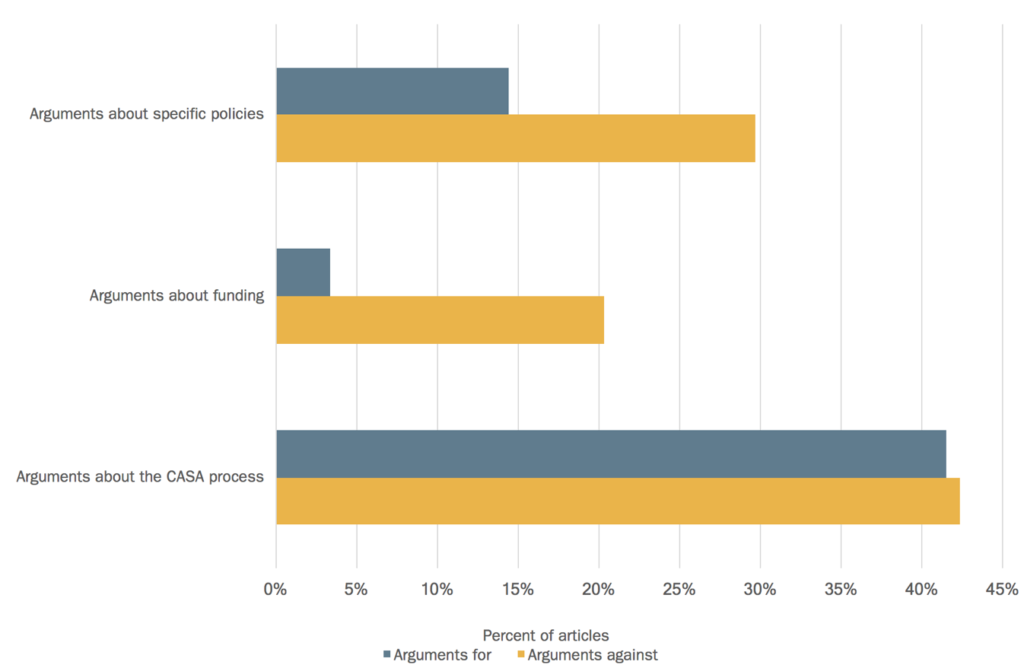
We found that proponents of CASA were sometimes quoted using “elephant triggers,” which occur when someone repeats their opposition’s argument, even to rebut it. By reiterating the opposition’s talking points — for example, the argument that the CASA proposals amounted to an elimination of local control — advocates may have inadvertently triggered people to focus on the opposition’s messages.
Recommendations
This analysis of coverage of CASA and the broader housing crisis, while preliminary, points to key steps that public health practitioners and their partners can take to elevate health and equity in future CASA discussions and in other discussions about housing policy. Specifically, advocates can:
Continue to lead with an overall strategy.
A strong overall strategy that elevates equity and health solutions in the news is a critical part of shaping public and policy debates. Investing time in developing a strong overall and communication strategy can be challenging when health departments and advocates are juggling many other tasks, but is essential to generating news coverage that helps advance equity-focused housing solutions. An overall strategy includes clearly defining the problem you want to address, the policy you are advocating for, who has power to make this change, and which allies can help make the case. A strength of the CASA coverage was its focus on solutions: The 3Ps were a major theme in the coverage because the equity cabinet — and the overall CASA process — focused on centering these solutions in communication materials as part of the overall strategy.
Ensure messages lead with values.
Communication research emphasizes that speaking about values is a core component of strong messages, and we found that opponents of CASA and other housing initiatives often used vivid language to evoke values like autonomy, preservation, and fairness as they described a struggle to protect a “small-town” community’s way of life. To connect with their audiences, equity, housing, and health advocates need to establish their shared values and link those values back to the issue at hand and the policy changes needed. The more advocates evoke strong values — like unity, interdependence, connectedness, pride of place, and others — whenever they communicate, the better their messages will connect with their audiences.
Additionally, while the statements on small-town values never explicitly included race or class, from a communication standpoint, and in terms of the practical implications about who gets to live in these “small towns,” they are heavily laden with racial and class connotations. Proponents of tenant protections and affordable housing should note that these messages already insert race and class into the conversation, even if it is implicit. Housing justice advocates can turn to recent research that shows that using values like unity, coupled with explicitly discussing racism and classism, can help advance equity-focused solutions that counter the effect of race and class being used to divide us.12
Develop relationships with reporters.
While equity and health did appear in the news about CASA and housing, there is room for more. By developing relationships with reporters and working with journalists, advocates can help make the housing and health equity connection easier to illustrate. This takes resources and time for advocates who often have full plates, so finding ways to fund and support developing communication capacity and strategy is critical.
Use opinion pages to advance racial and health equity frames.
While news articles did include coverage of equity and health related to housing, op-eds, blogs, letters to the editor, and other opinion pieces offer advocates opportunities to frame the issue in a way that advances equity and health solutions. Getting opinion pieces placed can then influence future news articles on housing as well.
Communication strategies should include elected officials.
Multiple elected officials were part of the CASA process, and it’s no surprise that they were frequently quoted, as they are often seen as formal spokespeople, and reporters know how to reach them. Public health staff and advocates can work more closely with their elected leaders who are champions of equitably focused housing policy to ensure they have solid messages that tie housing and health equity together and avoid repeating opposition arguments.
Amplify equity and public health voices.
While tenant groups that advance equity-focused housing policy did appear in the coverage, there are still many opportunities to increase their voices, along with the residents they work with. Additionally, public and mental health representatives were rarely quoted, which means there is a large opportunity to build capacity and develop communication strategies that leverage public health voices.
Conclusion
Communicating about any area of public health can be challenging, especially in efforts to advance policy change. Communicating about the housing crisis — with its complex causes and solutions, jargon, and layers of equity issues — is no exception. Equity-focused solutions, like protection and preservation, are harder to see, and the crisis (and even the language of crisis13), makes it seem inevitable and obscures the role and responsibility that local, regional, and state government have in creating opportunities for everyone to have access to housing — and to be healthy.
Acknowledgments
This report was authored by Laura Nixon, MPH; Katherine Schaff, DrPH; Pamela Mejia, MS, MPH; Daphne Marvel, BA; and Lori Dorfman, DrPH. Thank you to Heather Gehlert for providing editing support. And special thanks to Will Dominie and Melissa Jones, with the Bay Area Regional Health Inequities Initiative, for their invaluable insights and feedback.
References
1. Downing H. The health effects of the foreclosure crisis and unaffordable housing: a systematic review and explanation of evidence. Soc Sci Med. 2016;162:88–96.
2. Dearing JW, Rogers EM. Agenda-Setting. Thousand Oaks, CA: Sage; 1996.
3. Gamson W. Talking Politics. New York, NY: Cambridge University Press; 1992.
4. McCombs M, Reynolds A. How the news shapes our civic agenda. In: Bryant J, Oliver MB, eds. Media Effects: Advances in Theory and Research. New York, NY: Taylor & Francis; 2009:1-17.
5. McCombs M, Shaw D. The agenda-setting function of mass media. Public Opin Q. 1972;36(2):176-187.
6. Scheufele D, Tewksbury D. Framing, agenda setting, and priming: The evolution of three media effects models. J Commun. 2007;57(1):9-20.
7. Bay Area Regional Health Inequities Initiative, United States Federal Reserve. Housing instability and family health: An issue brief.
8. Dorfman L, Krasnow I. Public health and media advocacy. Annu Rev Public Health. 2014;35:293-306.
9. Aguilar-Canabal D. Senator Weiner launches three big bills to tackle housing woes. The Bay City Beacon. December 9, 2018.
10. Carson K. Prescription for a healthy Bay Area? Homes for all. San Francisco Chronicle. June 28, 2018.
11. Degan R. City, school officials talk about state response to housing crisis. Pleasanton Weekly. February 3, 2019.
12. Anat Shenker-Osorio, Ian Haney-López, Heather McGhee. The Race-Class Narrative Project. https://www.demos.org/race-class-narrative-project. Accessed May 15, 2019.
13. Frameworks Institute. “You don’t have to live here”: Why housing messages are backfiring and 10 things we can do about it. Frameworks Institute; 2016. http://www.frameworksinstitute.org/assets/files/PDF/You_Don’t_Have_to_Live_Here.pdf. Accessed May 15, 2019.




